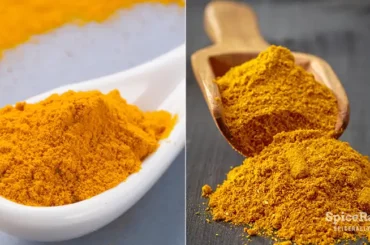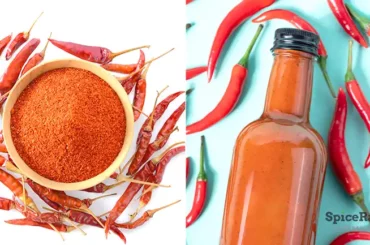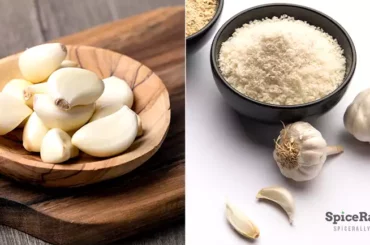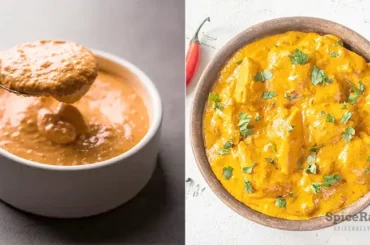If you’re an inquisitive food adventurer, you must be interested in learning about various types of curry powders. So, in this episode, we considered elaborating on Japanese curry powder vs Indian curry powder.
The key difference between Japanese curry powder and Indian curry powder is the proportions of the ingredients used in each blend. Indian curry powder usually contains more red chiles, making it hotter. And it usually has more robust spices than Japanese curry powder. While Japanese curry powder contains some exotic elements like dried mandarin peel and dried seaweed, we don’t find them in Indian curry powder.
Let’s dive right in and learn more about in what terms these two types of curry powders actually differ.
Japanese Curry Powder vs Indian Curry Powder- SpiceRally DrillDown
| Japanese Curry Powder | Indian/ Madras Curry Powder | |
|---|---|---|
| Base flavor | Warm and spicy | Warm and spicy |
| Key ingredients | Turmeric Fenugreek seeds Cumin seeds Coriander seeds Cinnamon Black pepper Ground ginger Cloves Cayenne pepper powder Star anise Nutmeg Fennel seeds Cardamom Dried mandarin/ orange peel Thyme Sage Bay leaves Might also contain the following ingredients: Dried kombu seaweed Dried shitake mushroom Paprika Allspice Dill seeds Szechuan peppercorns White pepper Nigella seeds Mexican oregano Mace Red chile powder Onion powder Soy extracts | Turmeric Coriander seeds Red chiles (paprika/ cayenne pepper, Kashmiri red chilies) Cinnamon Fenugreek seeds Cumin seeds Black pepper Cloves Black mustard seeds Garlic Ginger Could contain the following ingredients as well: Bay leaves Nutmeg Curry leaves Allspice Fennel seeds Cardamoms |
| The flavor Profile | Is less intense and robust than Indian curry powder, with an earthier, warm, spicy, savory and well-balanced flavor. It has a sweeter, citrusy, and sometimes salty undertone if seaweed or salt is included. | It is more intense and potent than Japanese curry powder. Indian curry powder has a warmer overtone with earthy and somewhat savory hints. It also has a prominent note of coriander, cumin, cinnamon, and black pepper. |
| Heat and spiciness | Less heaty and spicy than Indian curry powder | More heaty and spicier than Japanese curry powder |
| Texture | A fine, ground powder | A fine, ground powder |
| Color | It is usually yellowish or yellowish-orange in color. | It is typically brownish-yellow or brownish-orange. The color depends on the ingredients used. |
| Mode of usage in cooking | As an ingredient | As an ingredient |
| Usage in cooking | – Mainly used in Japanese curries, curry rice, curry roux making, and curry udon (noodles) – It is used to flavor up soups, and stews – Can be tossed with roasted vegetables – It is incorporated with rubs, and marinades – It jazzes up store-bought and homemade snacks | – Primarily used in Indian curries, meat, vegetable, and rice dishes – It is used to flavor up soups, and stews – Can be tossed with roasted vegetables – It is incorporated with rubs, and marinades – It jazzes up store-bought and homemade snacks |
| Variations | Not many variations exist. | Many variations exist depending on the household and regions across India |
| Origin | Japanese cuisine | Indian cuisine |
| Availability | Can be bought from any supermarket or grocery store across Japan. But it can be difficult to find Japanese curry powder outside of Japan. But could be available at the international spice aisle of leading supermarkets, Asian groceries, and online shopping sites. | Broadly available across India in any grocery shop and supermarket. However, you can find Indian curry powder under several brands from leading supermarkets, Asian stores, some groceries, and online vendors, when it comes to the Western market. |
| Storage | This can be stored with the rest of your dry spices and seasoning in an air-tight glass container. Refrigeration is not required. | This can be stored with the rest of your dry spices and seasoning in an air-tight glass container. Refrigeration is not required. |
| Mode of production | Both commercially made and homemade blends exist. | Both commercially made and homemade blends exist. |
| Culinary ingredient category | Spice blend/ seasoning | Spice blend |
Looking Deeper Into The Difference Between Japanese Curry Powder And Indian Curry Powder
We get various types of curry powder inherent to several nations worldwide. Indian curry powder and Japanese curry powder are such prominent types of curry powders it is vital to have an idea of their differences and similarities before using them.
As presented in the table above, these two spice blends have some noticeable differences, although they are only recognizable if closely monitored. Indian curry powder, also known as Madras curry powder, can be considered the mother of curry powders since Indian curries are the first dishes to emerge in the world with a “curry” vibe.

Mainly, the heat level of these two spice blends is undoubtedly comparable. You will usually find a variety of curry powders across India, and each can vary slightly depending on the region and household. All of them are considerably spicy and heaty compared to any variant of Japanese curry powder.
Japanese curry powder typically contains dried mandarin peel and dried kombu seaweed to define the oriental flavors of Japanese cuisine. This way, it becomes a well-balanced curry powder with milder and less intense flavor notes. Thus, if you’re a beginner thinking of and handling the spiciness and heat of curry, we suggest that Japanese curry powder is an excellent ingredient to start.
Distinction In Usage…
The usages of both spice blends are similar, although the dishes can have different standards for the two nations. However, both spice blends have their own way of adding depth, color, and aroma to relevant dishes. We cannot determine that one is superior to the other; it solely depends on how you take it as a food lover!
Can Indian Curry Powder Be Used In Place Of Japanese Curry Powder And Vice Versa?
The number of significant similarities apart, Indian curry powder can still be used in place of Japanese curry powder and vice versa in certain instances. But you should be ready to accept the difference in flavor and depth they both offer.
For example, you will not get the desired deep intensity if you use Japanese curry powder instead of Indian curry powder. And, things would work the same way back when you get an overpowering effect when Indian curry powder is used instead of Japanese curry powder.
Therefore, we recommend you use these spice blends as substitutes only in the recipes that call for each of them as secondary ingredients.




